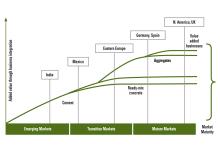
There is a feeling in some circles that the news that
I think to many in the industry that it did, given that the scheme was announced on a Friday evening in a short statement from both companies saying they believed that, given the strong complementarity of their portfolio and the cultural proximity between the two companies, there is rationale in considering a potential merger that could deliver significant benefits to customers, employees and shareholders.
The statement continued that the discussions “are based on principles consistent with a merger of equals which build on the strengths and identities of the two companies.
“No agreement has yet been reached and no assurance can be given that these discussions will lead to a definitive agreement. Holcim and Lafarge would inform the public of any material developments in this respect.
These material developments were not long in coming, and on the following Monday a plan that must have taken months to work out was unveiled, naming the chairman and CEO of the proposed new entity, LafargeHolcim, along with plans on how to satisfy the competition authorities: a series of divestments with a rumoured two-thirds of these being in Europe and the rest outside the continent.
To both companies, and many observers, such a merger makes sense, given that both groups have been busy cutting debt since the economic crisis started and have plants that are under-producing while energy prices are sky-high.
As to whether such a mega-merger will be good for the industry, and more importantly the customers, remains to be seen.
Certainly, the views of analysts varied, but Imran Akram, chief executive at IA Cement (advisers to the global cement industry), saw the positive side saying that both companies are to be congratulated on “this game-changing step to create the ultimate merger in cement.”
He said the disposal process represented a golden opportunity for regulators to introduce new players and increase competition in their cement markets. Significant disposals would suit LafargeHolcim, which would then be able to reduce debt levels and begin to pursue expansion projects in new markets.
“This in itself is likely to be very welcome after years of cost-cutting and retrenchment. The disposals will also lead to an unprecedented shake-up of industry structure. Many emerging market cement companies could be in a position to purchase mature market assets. The cement industry just became even more exciting,” he is quoted as saying.
Whatever happens, the deal which is scheduled for closure in the first half of 2015, still has a lot of hurdles to jump, even though both companies have done their best to minimise this.





